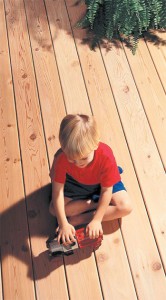Everyone wants to go green, but because the movement has been around for so many years, it’s hard for homeowners to get a firm grasp on what products will keep the environmental footprint created by their homes smaller.
Take natural wood products, for example. Many homeowners think using Western red cedar for decks, siding or other garden structures depletes the forest, when in fact, the exact opposite is true. Third-party forest-certification systems monitor forests, forest managers, loggers and the milling industry to ensure forests are legally harvested, replanted and sustainably managed. If you were to compare the number of trees growing today with the number from 100 years ago, you’d discover certified forest managers have increased that number, helping to keep the air cleaner.
Another interesting fact is that the manufacturing process to turn cedar trees into deck planks has a much smaller carbon footprint than what is associated with the production of other commonly used building materials like steel, cement, vinyl (PVC) and composites. Plus, if you choose to leave your deck a natural color — allowing the Western red cedar to age into silvery gray — you will have prevented a multitude of volatile organic compounds from being exposed to the air and water ecosystem.
As a building product, natural wood is an excellent choice for decks, siding, raised garden beds, arbors and even garden benches. It’s extremely versatile and easy to build with, because it can be cut and fastened together with other pieces or with another material — all right at your home. Using natural cedar universally in your backyard will also provide your home with a beautiful accent color that you won’t have to repaint or stain if you leave it natural.
Another green factor of using natural wood is found in the disposal process. The Western Red Cedar Lumber Association says a deck made of cedar lasts for decades. Once that life cycle is over — because it’s a natural material — wood breaks down in landfills quickly and easily, all while releasing minimal carbon dioxide. On the other hand, the wood could be used once again, reclaimed or re-purposed for another use.
If you’ve been looking to improve your environmental footprint, but were worried that those home improvement projects on your to-do list were going to hinder your achieving that goal, now you know you can use natural wood products like Western red cedar and be worry free. So build that deck, replace the siding or add some beautiful structural elements to the backyard, and enjoy having a smaller environmental footprint at your home.
This article is courtesy of Brandpoint.
